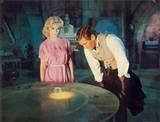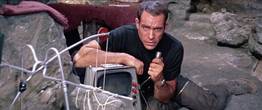1960s
The Time Machine (1960)
 This is the classic time machine story, with a fantastic demonstration of an object entering the 4th dimension from the point of view of people in the present. The second half is interesting because it might signify a future in which some humans evolve into a different species (becoming cannibals called the Morlocks) and in which our future human descendants (the Eloi) become like hedonistic cattle (with little interest in science and progress).
This is the classic time machine story, with a fantastic demonstration of an object entering the 4th dimension from the point of view of people in the present. The second half is interesting because it might signify a future in which some humans evolve into a different species (becoming cannibals called the Morlocks) and in which our future human descendants (the Eloi) become like hedonistic cattle (with little interest in science and progress).
Starring: Rod Taylor. Based on the novel by H. G. Wells. Directed by George Pal.
Sources: IMDb | RT | MRQE | Wikipedia | Script
Village of the Damned (1960)
These creepy children with blond hair are a group of dangerous mind controllers gifted in self-defense, mind reading, and stoicism. They are psychically linked together in a collective of brainpower, with the potential to help make advances in science and contact with aliens on other worlds.
Starring: George Sanders, Barbara Shelley, Martin Stephens. Based on a novel by John Wyndham: The Midwich Cuckoos. Directed by Wolf Rilla.
Sources: IMDb | RT | MRQE | Wikipedia
The Day the Earth Caught Fire (1961)
Mostly set in a newsroom with a team of reporters uncovering information about an apocalyptic scenario in which nuclear testing changes Earth’s axis for the worse.
Starring: Edward Judd, Janet Munro, Leo McKern. Written by Wolf Mankowitz, Val Guest. Directed by Val Guest.
Sources: IMDb | RT | MRQE | Wikipedia
Robinson Crusoe on Mars (1964)
 Begins with a NASA inspired space sequence (using typical astronaut talk, procedure, ship detachments, plausible landers) with U.S. astronauts orbiting and researching Mars. After a forced crash landing, most of the middle of the film is about an astronaut's, 'Kit' Draper's (Paul Mantee), struggle to survive and overcome isolation. In the third part 'Kit' Draper struggles to communicate with an humanoid alien (Victor Lundin) and evades alien crafts (none of the aliens are native to Mars).
Begins with a NASA inspired space sequence (using typical astronaut talk, procedure, ship detachments, plausible landers) with U.S. astronauts orbiting and researching Mars. After a forced crash landing, most of the middle of the film is about an astronaut's, 'Kit' Draper's (Paul Mantee), struggle to survive and overcome isolation. In the third part 'Kit' Draper struggles to communicate with an humanoid alien (Victor Lundin) and evades alien crafts (none of the aliens are native to Mars).
Haskin makes Mars feel alien by using a red sky and locations like Death Valley National Park, California. He wanted scientific realism (except for a few dramatic fireballs), so the film is like a time-capsule of our understanding (and misunderstanding) of Mars at that time. Some of the interest for geology and rocks in the screenplay comes across in the film, and it has a few noteworthy gadgets (miniature camera, portable radar and omnicom) that we like to mention.
In the Criterion DVD extras, a documentary smartly notes that the stranded astronaut explores many different environments on Mars in contrast to George Lucas' tendency to sometimes portray one environment per planet (desert planet, jungle planet, city planet, snowy planet, swampy planet).
Note: Although the credits mention Daniel Defoe's novel, "Robinson Crusoe", as inspiration, the filmmakers hated the movie title and instead based the film on a realistic version of the screenplay (Criterion DVD Commentary).
Starring: Paul Mantee, Victor Lundin. Screenplay by John C. Higgins, Ib Melchior. Directed by Byron Haskin.
Sources: IMDb | RT | MRQE | Wikipedia
Crack in the World (1965)
A distinguished scientist detonates a nuclear bomb to burn into the core of the Earth and reach a near limitless energy resource (magma), but his lead geologist (Dr. Rampion) believes the plan threatens to disintegrate the planet as we know it.
It would be interesting to learn more about the idea of a team of scientists trying to harness magma to solve our future energy needs. Probably a better concept would be to construct a space device for harnessing the Sun's power. In any case, a year after the film the theory of plate tectonics would falsify the movie's dramatic premise (of a crack spreading around the earth), and we have more information about the creation of our moon (Dr. Rampion is skeptical that we could know about ancient moon formations).
However, the movie is worth watching for the serious way most of the scientists operate in the project (Project Inner Space), and for minor themes of nuclear testing side effects, creation of moons, mad scientists, communities of scientists, X-ray treatments, and view screens.
Starring: Dana Andrews, Janette Scott, Kieron Moore. Written by Jon Manchip White, Julian Zimet. Directed by Andrew Marton.
Sources: IMDb | RT | MRQE | Wikipedia
Fantastic Voyage (1966)
An excellent illustration of a voyage to the small [also look for The Incredible Shrinking Man (1957) and Innerspace (1987)]. In the plot a scientist invents stable and longer lasting miniaturization technology, but he gets injured before he teaches his discoveries to anyone, locking the secrets to how the improved technology works in his mind. So a doctor and some military personal use a miniature vessel (the Proteus) to help heal the scientist.
Most such ideas about the micro world lack explicit scientific credibility, but they allow us to adopt a different perspective and to use similar thought processes that some scientists use in thought experiments. For example, Carl Sagan compares us to little universes (Cosmos #2), Einstein used various thought experiments in his thinking, and, more recently, Brian Greene pretends to travel to the minute quantum level as an analogy to quantum concepts (The Elegant Universe).
Starring: Stephen Boyd, Raquel Welch, Edmond O'Brien, Donald Pleasence. Written by Harry Kleiner, David Duncan, Otto Klement, Jerome Bixby. Novelized by Isaac Asimov. Directed by Richard Fleischer.
Sources: IMDb | RT | MRQE | Wikipedia | Transcript
2001: A Space Odyssey (1968)
 Intense SF vision of realistic space flight, speculative spacecrafts, high computer progress and automation, possibly an ancient alien transport and information system, a star child (perhaps an intelligent space dwelling being), and alien technology (the Monolith) that is so advanced in science it would look to us like magic (per one of Clarke's maxims of prediction: "Any sufficiently advanced technology is indistinguishable from magic"). It flaunts a Nietzschean-like evolution of intelligence from our ape ancestors, to humans, to machines, to a star child.
Intense SF vision of realistic space flight, speculative spacecrafts, high computer progress and automation, possibly an ancient alien transport and information system, a star child (perhaps an intelligent space dwelling being), and alien technology (the Monolith) that is so advanced in science it would look to us like magic (per one of Clarke's maxims of prediction: "Any sufficiently advanced technology is indistinguishable from magic"). It flaunts a Nietzschean-like evolution of intelligence from our ape ancestors, to humans, to machines, to a star child.
The movie hints at a vast potential for progress by beginning from an alien perspective and repeating the probe/monolith symbols to get us to feel an alien presence and technological superiority (or at least sense the same mystery the characters feel from their new discoveries).
It has many little gems of speculation, such as its subtle stance on artificial intelligence. Kubrick was careful to offer opposing points of view and cite difficult questions. The script never claims that HAL is intelligent or sentient, and it doubts whether we could know if HAL has emotion. It notes that some scientists claim HAL merely mimics sentience (so we would be wrong to list HAL as an example of A.I. without this qualification). Though it remarks that HAL seems intelligent and emotional (and could be for all we know). (The novel suggests Turing's imitation game, aka the Turing test, as an intelligence test.)
The scientific value of the movie is in its fabric. The astronauts work methodically similar to the way I see NASA conduct its missions on the NASA channel. They use computers and communications with earth to guide their troubleshooting and repairs. It also replaces the emphasis on militaristic chains of command of Star Trek or Forbidden Planet with a more modern, scientific, technical way of operating. There are scientific flaws in specific details, but science itself is littered with failed attempts that were crucial to future scientists. Where would we be without the reintroduction of the ancient Greeks into western civilization? (So, yes, Aristotle is wrong about almost everything while also being very important arguably. See James Burke's documentary series, Connections, for this sort of argument.)
Timothy Ferris uses 2001 as an example of the thesis that aliens may already know about us and we might find evidence of them as we continue to explore space (p. 375, Coming of Age in the Milky Way). The movie is also an example of an alien pathway system (with Trumbull's light effects near the end of the movie) and perhaps a cosmic intelligence network. The mutual desire of the humans and the aliens to search out intelligent life may be nature's way of evolving an intelligence on a massive scale (much in the same way Carl Sagan imagines in his Cosmos series and in Contact).
The film has high artistic appeal and is one of the most influential SF movies. Even though the climax has humans combating our flaws and a homicidal computer, it leaves us with visions of an advanced space civilization, a new space species, and a chance for science and technology to be important to our future. Believe it or not this is rare in SF!
Starring: Keir Dullea, Gary Lockwood, William Sylvester. Screenplay by Arthur C. Clarke, Stanley Kubrick. Based on short stories by Arthur C. Clarke. Directed by Stanley Kubrick.
Sources: IMDb | RT | MRQE | Wikipedia | Technovelgy / News | Screenplay
Links: Google Directory | 2001 Explained | Archive | Facts/FAQ | 2001 Principle | HAL's Legacy
Other 1960s SF and Related Movies
-
Quick mentions (future possible entries): X - The Man with the X-Ray Eyes (Dir. Roger Corman, 1963), First Men in the Moon (Dir. Nathan H. Juran, 1964), Planet of the Apes (Dir. Franklin J. Schaffner, 1968), Marooned (Dir. John Sturges, 1969)
-
La Jettée (1962). A short mind bender about strange experiences during time travel experiments. The story is told through a succession of still images (except one moving shot). Marker's La Jettée is excellent when you get in the right state of mind; you have to pretend you found it as an alien artifact and are about to witness some mysterious records. Starring: Jean Négroni, Hélène Chatelain, Davos Hanich, Jacques Ledoux, Étienne Becker. Written and directed by Chris Marker. Sources: IMDB | RT | MRQE | Wikipedia | Script | Paul Smith
-
Fail-Safe, Dir. Sidney Lumet, 1964. Numerous technical errors (and difficult to overcome safety precautions) initiate a nuclear strike on Moscow by six Vindicator supersonic bombers. The US decides to help Russia to destroy the bombers and makes other quite unusual decisions to avoid total nuclear war. Sources: IMDB | MRQE | Wikipedia | Google Directory
-
Fahrenheit 451 (1966). Presents a future in which firemen become responsible for book burnings to prevent people from thinking independently; consequently, most people become insipid while a few begin resistance movements. Starring: Oskar Werner, Julie Christie, Cyril Cusack. Based on the novel by Ray Bradbury. Directed by François Truffaut. Sources: IMDb | RT | MRQE | Wikipedia
 We are looking for people with skills or interest in the following areas:
We are looking for people with skills or interest in the following areas:
